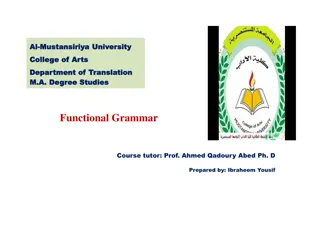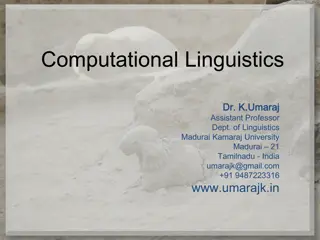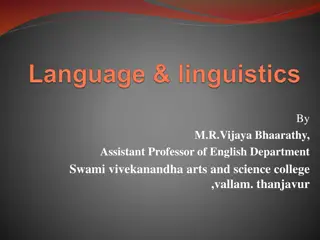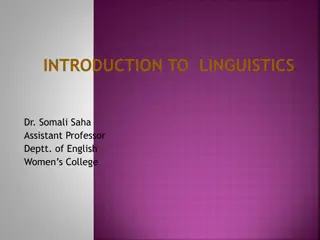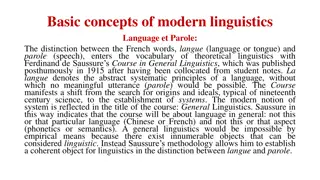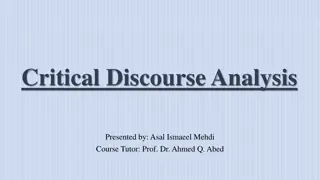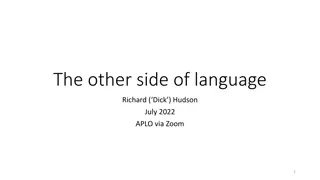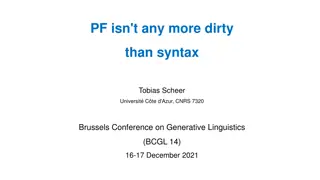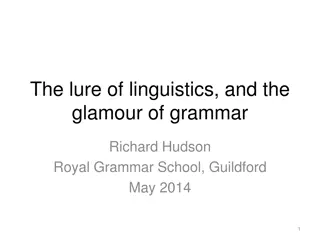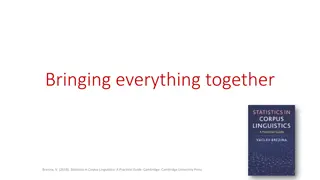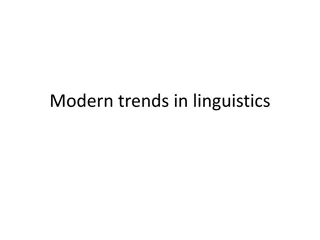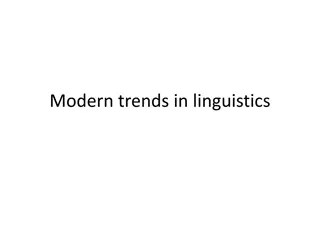Understanding Language: An Overview of Linguistics
Linguistics is the scientific study of language, a complex system of sounds, words, and patterns that humans use to communicate thoughts and feelings. Language consists of phonology (sounds), morphology (words), syntax (sentences), semantics (meaning), and pragmatics (contextual meaning). Different views on language origins include the Divine Source Theory linking language to divine creation and the Natural Sound Source Theory suggesting early words were imitations of natural sounds.
Download Presentation

Please find below an Image/Link to download the presentation.
The content on the website is provided AS IS for your information and personal use only. It may not be sold, licensed, or shared on other websites without obtaining consent from the author. Download presentation by click this link. If you encounter any issues during the download, it is possible that the publisher has removed the file from their server.
E N D
Presentation Transcript
What is Linguistics? What is language? Means of communication 'Language is purely human and non-instinctive method of communicating ideas, . emotions and desires by means of voluntarily produced symbols. (Edward Whorf Sapir 1921). Language is a 'System of sounds, words, patterns, etc, used by humans to communicate thoughts and feelings.' (Oxford Advanced Learner's Dictionary. 1989)
Language is a 'System of sounds, words, patterns, etc, used by humans to communicate thoughts and feelings.' (Oxford Advanced Learner's Dictionary. 1989) System of sounds Phonology Sounds 44 Letters 26 System of words Morphology A to Z Systematic combination of letters/sounds Morpheme Smallest meaningful unit in the system of language CAT ACT (CTA, ATC, TCA)
Language is a 'System of sounds, words, patterns, etc, used by humans to communicate thoughts and feelings.' (Oxford Advanced Learner's Dictionary. 1989) System of patterns (Sentences) Syntax S+V+O I eat Chocolate He eats Chocolate System of meaning Semantics My uncle sleeps standing on a single toe Cake eats Cat System of contextual meaning Pragmatics
System of contextual meaning Pragmatics I will see you. Promise threat What is Linguistics? Linguistics is a science. It makes scientific study of the language.
Some Views about Language The Divine Source Theory : According to one view, God created Adam and "whatsoever Adam called every living creature that was the name thereof' (Genesis, 2: 1 9). According to Hindu tradition, language came from goddess Saraswati. In most religions, there appears to be a divine source that provided humans with language. Generally, every society has a divine story to tell about the origins of its language. We also notice that the alphabetical symbols or ideographs used in writing are often associated with divine images.
Some Views about Language The Natural Sound Source Theory : Another view of the origin of human speech is based on the concept of natural sounds. The theory suggests that first words were imitations of the natural sounds which early men and women heard around them. The fact that all languages have some words which seem to echo naturally occuring sounds could have led to this theory. "Cuckoo", "bang", "buzz". "hiss". "bow-wow", etc., are some examples from English. In fact, this type of view has been called the "bow-wow theory" of language origin.
Some Views about Language The Pooh-Pooh Theory : In 1871, in his Descent of Man, Darwin proposed that like man himself his language also developed from a more primitive form. probably from expressions of emotions. For example, a feeling of contempt is accompanied by the action of puffing of air out through the nostrils or the moutth and this action makes sounds like "pooh" or "pish" . The critics of Darwin's theory scornfully named it the Pooh-pooh theory.
Some Views about Language The Ding-Dong Theory : Muller, a contemporary of Darwin, proposed the ding- dong theory of the origin of language. According to this theory, there was a mystic relationship between sound and meaning. There was an instinct in the primitive being, by which every impression received a vocal expression from within. Just as a particular sound is produced when any object is struck by a solid body, similarly human being's mind gave a particular response to every impact the world made upon it. For example, the sight of a snake rang a bell and the primitive human instinctively said "snake".
Animal Communication Vs Human Language Use of sound signals The use of sound signals is perhaps the most obvious characteristic of human language. human beings can transfer language to visual symbols (as in the case of sign language, or writing) and to tactile symbols (as in the case of Braille). Arbitrariness There is generally an apparent relation between the signal and the message the animal wishes to convey. On the other hand, if we look at human language-carefully, we see that except in the case of onomatopoeic words or expressions, there is no logical relationship between the signal and the message.
Animal Communication Vs Human Language The Need for Learning The role played by 'learning' in animal communication is very little. Their language is more or less genetically inbuilt. Humans have to learn the language with proper exposure. Noam Chomsky LAD(Language Acquisition Device) Displacement Most animals can communicate about things in the immediate environment only. A bird utters its cry of danger when danger is present. It cannot give information about a danger which is removed in time and place. Human beings , on the other hand, can communicate about things that are absent as easily as about things that are present. This phenomenon, is known as displacement..
Animal Communication Vs Human Language Creativity Most animals have a fixed number of messages which are sent in clearly definable circumstances. Human beings, on the other hand , can talk about anything they like. They can produce and understand utterances which they have never produced or heard before. It is also not necessary that the same situation would make them utter the same thing each time. Duality or double articulation Animals who use sound signals for communicating have a finite set of basic sounds . The number of basic sounds varies from species to species. Cows, for example, have less than ten, whereas foxes have over thirty. In contrast, human language works very differently. Every language has a set of thirty to forty basic sounds which are called phonemes.
Animal Communication Vs Human Language Patterning Human language, on the other hand, has well defined internal patterns. There are firm restrictions on which elements (sounds, words, etc.) can occur together, and in which order. For example, take the sounds lo', 'p', 't', 'sf in English. These sounds can be arranged in the following six ways only : 'spot', 'stop', 'pot', 'pots', 'top' and 'tops'. Other possibilities like 'tsop', 'ptos', 'opst', are not possible because the rules of English do not allow these. Structure Dependence Human beings instinctively understand the patterned nature of language, and manipulate 'structured chunks' of language, e.g., they understand that a group of words can be, at times, the structural equivalent of one word.
Animal Communication Vs Human Language Reciprocity/Interchangibility Any speaker/sender of a linguistic signal can also be a listener/receiver Rapid fading Spontaneous usage Turn-taking Complete feedback
What is a Language ? What is Hindi or English or Tamil or Urdu? Language is not a monolithic object. It is a human phenomenon, which is as complex as human relationships in a society. (a) There is no such thing as 'English', 'Hindi' or 'Tamil'; they are labels used to refer to abstractions. What we refer to by English, Hindi and Tamil is a network of varieties; varieties of English, varieties of Hindi and varieties of Tamil. British English, American English, Canadian English, for example, are regional varieties of English. Bihari Hindi, UP Hindi, MP Hindi are regional varieties of Hindi. The abstract system is called langue. An individual's speech act (his actual speaking) is called parole; this varies from person to person. Parole and langue together constitute language.
(b) No two persons speak alike. (c) When a group of individuals share particular ways of speaking, the group uses a dialect. (d) A dialect spoken in a geographical area is called dialect. (Braj-bhasha and Khari-boli are regional dialects of Hindi) Rural and urban dialects are regional dialects. (e) Dialects based on social stratifications are called social class dialects and caste dialects (e.g., upper-class dialect, Brahmin dialect, etc.). They are language varieties used by the members of certain 'classes' and 'castes'.
(f) In terms of the history and growth of languages (i.e. examining language varieties from a temporal point of view), we may talk of Elizabethan English, Victorian English; sixteenth-century Hindi, eighteenth-century Hindi, and so on. (g) A prestige dialect is a dialect emulated by speakers of other dialects (i.e. B.B.C.' English, Khari-boli, etc.) In due course the prestige dialect acquires the status of the standard language.
(h) If two or more varieties of a language differ in grammar, vocabulary and pronunciation, the differences are called dialectal. Variations in pronunciation alone are differences of accent. When we talk about dialects, we refer to the dialects of a language'. This means that every dialect is a variety of a language. How and when a dialect is given the label of a language depends not on linguistic but on socio-political factors. This means that every dialect is a potential language. Whether a linguistic system used by a speech community is a dialect or a language, is often decided by social attitudes. For example, some people think that Konkani is a dialect of Marathi, whereas others say it is a language. Sometimes it is decided on the basis of similarities between the systems and mutual intelligibility.
(i) The study of dialects is known as dialectology. Dialect distinctions can be plotted on a map. Lines demarcating areas exhibiting a particular feature and so dividing them off from areas exhibiting other features are called isoglosses. Isoglosses criss-cross, overlap, and diverge, yielding bundles of isoglosses. A linguistic atlas is a collection of maps showing the prevalence of particular speech forms in particular areas. In fact, no two speakers speak exactly the same dialect. speaker has certain characteristic features reflected in his way speaking. We may say that each individual has his idiolect (idio = individual; -lect = variety of language). .
II. If a language variety has certain features which are typical of certain disciplines/topics/fields/occupations and social roles played by a speaker, it is referred to as register (e.g. the journalistic register--the language of journalists; the legal register--the language of law/lawyers; the scientific register, and so on). III. It is possible to have one register but different styles, depending on the speaker's intention, individual preferences, and the relationship between the speaker and the hearer. Thus a speaker may decide to use a technical register but change his style from highly formal, to formal, to informal, to highly informal on the basis of whom he is talking to.
IV. The mode or medium of expression may be spoken or written. The use of language varies according to the medium. For instance, there are no punctuation marks in speech. V. An extreme form of informality in the use of a language is called slang. One man's slang may not be another man's slang. The words "hippie' and 'pot' are slang for some but not for others. The word slang' itself has an archaic meaning in British English; it means 'to swindle'. Jargon is a term used to refer to a set of words or expressions used by a specific group among themselves. Every trade has its own jargon; linguists have 'structures', deep-structures', 'inter-lingual' and 'intra-lingual', 'inter- language' and 'interim-language', and so on. . .
Cant is a term used to mean the secret language used by a class or sect. The term argot is also used to refer to the jargon or slang used by a particular class or group of people. In the nineteenth century, it was used especially to refer to the jargon used by thieves. To two-finger' is 'to pick-pocket'. Cant and argot may be used to mean the same thing: the thieves' cant or argot. The language of the 'underworld' in Calcutta has been substantially documented by Bhaktiprasad Mallik in his book Language of the Underworld of West Bengal (1972). In his description of the Calcutta underworld language we find twenty-one words for 'bomb', and forty-one for police and so on. 'Secrecy' and 'use in a closed communicational network' are the marked features of this variety of a language.
VI. The social use of language like using stereotyped express for greeting (i.e. "good-morning', 'namaskar', 'vanakkam , etc) and leavetaking (e.g. 'good-bye') has been given the name phatic communion by Bronislav Malinowski. He defined it a type of speech in which ties of union are created by a mere exchange words'. VII. On the basis of similarities and dissimilarities languages have been grouped into broad language families and sub-families as the Indo- European, Dravidian, etc. The charts A to H given on pp. 11-12 show some important languages in some of the language families. VIII. Edward Sapir (1884-1939) has classified languages according to the type of mechanisms of synthesis that they use. He proposed a typological classification based on the interrelation of three sets of distinctions.
A. GRAMMATICAL CONCEPTS I. Basic or concrete concepts, e.g. play; II. Derivational concepts which give an added or altered meaning to the root without involving the rest of the sentence, e.g. player; III. Concrete relational concepts where the rest of the sentence is involved, e.g. players (the change from 'player' to 'players' requires a change in the accompanying verb: smokes' to smoke'); IV. Pure relational concepts which are purely relational like word order, e.g. see the players vs the players see. Concepts of type I are expressed by independent words whereas II and III are expressed by affixes or by internal modification of the 'root', type IV uses all these possibilities together with word order.
B. GRAMMATICAL PROCESSES OR TECHNIQUES I. Isolating languages are those that identify the word with the root. II. Affixing languages are those that affix modifying elements to the root. III. Symbolic or inflective languages are those that employ internal modification of vowels or consonants. Affixing may be (a) regular or (b) irregular. Fusion may be (a) regular or (b) irregular. The distinctions mentioned may be shown as follows. agglutination: good + ness = goodness regular fusion: book + s = books irregular fusion: deep + th = depth symbolism: goose + plural = geese
C. I. Analytic languages are those that do not combine concepts into single words, such as Chinese. II. Synthetic languages are those that combine concepts with certain restraints, such as Latin. III. Polysynthetic languages are those that combine concepts with extreme elaboration; Amerindian (American Indian) languages, such as Yana, Nootka, etc.
By employing these three sets of distinctions, languages can be classified as follows. Conceptual type Technique Degree of affixing Chinese I+IV English I+II+III+IV Turkish I+II+IV isolating fusional agglutinative analytic analytic synthetic I. II. Basic or concrete concepts, e.g. play; Derivational concepts which give an added or altered meaning to the root without involving the rest of the sentence, e.g. player; III. Concrete relational concepts where the rest of the sentence is involved, e.g. players (the change from 'player' to 'players' requires a change in the accompanying verb: smokes' to smoke'); IV. Pure relational concepts which are purely relational like word order, e.g. see the players vs the players see.
By employing these three sets of distinctions, languages can be classified as follows. Conceptual type Technique Degree of affixing Chinese I+IV English I+II+III+IV Turkish I+II+IV isolating fusional agglutinative analytic analytic synthetic Sanskrit, Hindi, Telugu, Tamil, Bengali, etc., unite long strings of linguistic forms that show tense, aspect, number, gender, person, etc., and blend them into single words. Each linguistic element has a distinct and fixed meaning and the elements are combined to form words. They are synthetic and agglutinative languages.
IX. The significant similarities underlying all languages are called language universals.
Language in Contact I. Two or more languages that come into contact may influence one another. II. A monolingual person is someone who has the ability to use only one language. A bilingual person can use two languages. coordinate bilingual person can use two languages with equal ease but someone who is a subordinate bilingual uses one language well (that language is called the dominant language) and the other language not so well. There may be degrees of bilingualism. A multilingual person can use more than two languages. III. A pidgin language is a 'marginal language' which is derived from 'full-sized' source languages by drastically simplifying their structure and vocabulary; it is not used by a speech-community as a native language; for example, 'gras bilong hed' means 'hair' in Chinese Pidgin English. A creole language is a pidgin language which is used by a speech-community as a native language. The point to note here is that pidgin and creole are rule-governed creative systems.
IV. A marked difference between formal and informal style in a language that produces a kind of bidialectism has been called diglossia. For example, the difference between written or high Tamil (symbolized as H) and spoken or low Tamil (symbolized as L) is a case of diglossia. This is a case of switching between two dialects or styles. V. If switching takes place between two or more languages in communication, it is called code-switching. For example, one may use Hindi for one friend and English for another. In a multilingual setting in India today, it is quite common for speakers to switch from Hindi/Tamil/Telugu to English according to their topic of discourse and the person(s) they are talking to. If one uses a language and mixes words, phrases, and sentences from another language, it is called code-mixing.
SOCIAL ASPECTS OF LANGUAGE The meaning(s) of an utterance (sentence, clause, phrase. word...) does not depend entirely on its form; it also depends on its function in a setting. The meaning of what is said depends on who says it to whom, when, where, and with what effect. In other words, the context of situation in which an utterance is said is. very important in deciding its overall meaning. The following sentence is interrogative in form but means a polite request in a dining hall situation: Can I have the salt, please?'. The following factors help us understand the meaning and use of language. (a) Nature of participants: The relationship speaker/speakers and the hearer/hearers, their occupation, sex, between the socio-economic status, etc, (b) Nature of participation: Face to face talk, telephonic conversation, large group, small group, classroom, public meeting etc.
(c)Role of participants: Teacher-student, boss-subordinate, husband-wife, father-son, seller-buyer, etc. (d) Function of speech events: Persuasion, order, request, ritual, verbal, play, etc. (e) Mode or medium: Speech, writing, reading from a written script, etc. (f) Kind of discourse: Epic poem, conversation, political speech, reporting, dirty jokes, etc. (g) Topic of discourse: Science, art, economics, politics, linguistics, etc. (h) Physical setting: Public-private, noisy-quiet, seminar-classroom, etc. (i) Socio-cultural situation: Englishman to Englishman, Englishman to Indian, Indian to Englishman, Tamilian to Punjabi, etc.
(j) The real-world knowledge or beliefs the participants bring to a discourse may be personal, religious, as a member of some group, etc. (k) The speaker's desire or lack of it to commit himself or herself on a position may be non-committal, may have strong views on something, etc. (l) A combination of all the factors mentioned above. Put differently, a speaker's competence or ability should include linguistic abilities such as the ability to construct and understand sentences never heard or uttered before in his life, the ability to accept as grammatical or reject as ungrammatical any utterance, quite apart from the ability to say whether it is a sensible utterance or not, and the ability to interpret sentences in more than one way in the presence of ambiguity (e.g., 'old men and women' may mean old men and old women' or 'old men and women').
It should also include communicative abilities such as the ability to make appropriate decisions as to when to speak and when not to, the ability to decide what to say to someone and in what manner and other such non- linguistic factors. The ability to use language appropriately is one's communicative competence.
LINGUISTICS: ASPECTS, LEVELS, BRANCHES I. Linguistics is a scientific study of the systems/principles under lying human languages. It is scientific because it follows the general methodology of science (controlled observation, hypothesis-formation, analysis, generalization, prediction, testing by further observation, and confirmation, modification or rejection of the hypothesis). II. Linguistics has two major aims: to study the nature of language and establish a theory of language, and to describe a language and all languages by applying the theory established. III. A linguist is a person who studies language in all its aspects. A person who knows several languages is a polyglot. A linguist is not necessarily a polyglot and a polyglot may not be a linguist.
IV. The total subject-matter of study, language or languages, may be examined from a historical angle. If the study deals with changes that occur in course of time, it is called diachronic linguistics (e.g. the history and development of Hindi); if the study deals with the description of language at a given point of time, it is called synchronic linguistics. The comparison of two or more diachronic descriptions is called comparative linguistics or historical comparative linguistics (e.g. a comparative study of Dravidian languages). The comparison of two or more synchronic descriptions is called contrastive linguistics (e.g., a contrastive study of the sound systems of modern Tamil and Hindi). V. Language is an arbitrary system of articulated sounds made use of by human beings for communication and expression. Language has sounds, words, sentences, and meaning; all the different levels are studied. It is useful to set up different but inter-related levels of analysis to describe the sounds, words, sentences and meanings of human languages. Linguists have set up phonological, morphological, lexical, syntactic and semantic levels of analysis.
(i) Phonetics is the study of the articulation, transmission and reception of speech sounds. (ii) Phonology is the study of the organization of the units of the sounds of speech into syllables and other larger units. The phonology of a language is a description of the systems and patterns of sounds that occur in that language. (iii) Morphology is the study of words. (iv) Syntax deals with the combination of words into phrases, clauses and sentences. (v) Semantics is concerned with the study of meaning in all its aspects. The term grammar is sometimes used to refer to morphology and syntax, some linguists use it to refer to the entire language.
(vi) Graphology is the study of all the conventions used in representing speech in writing. (vii) Lexicology is the study of lexical items and their collocational relations. Some linguists make a distinction between microlinguistics and macrolinguistics. The former refers to a narrower and the latter to a much broader view of the scope of linguistics. According to the microlinguistics view, languages should be analysed for their own sake without any reference to their social function, to the manner in which they are acquired by human beings, and to the literary or communicative function of language. Macrolinguistics embraces all these aspects of language.
Psycholinguistics, Language and Mind, Logic and Language, Language Acquisition Historical and Comparative Linguistics (Philology) Communication and Communicology Ethno-linguistics Sociolinguistics, Bilngualism, Language Planning, Minority Languages, Language and Sex, Pidgins and Creoles, Language and Society Translation and Interpretation Dialectology Descriptive Linguistics Grammar Morphology Syntax Phonology Semantics Phonetics Lexicology Semiotics/Semiology Neurolonguistics, Speech Pathology, Deviant Language Behaviour etc. Pragmatics Anthropological Linguistics Graphalogy Mathematical Linguistics Language Teaching and Learning Contrastive Linguistics Error Analysis Stylistics and Discourse Analysis
The term 'language includes the entire human potential for speech and writing, both mental and physical. Its actual manifestation that we see and hear in terms of individual utterances (i.e. speaking) is called parole. The abstract system behind the manifestation shared by a social group is called langue. The system (langue) together with its manifestation (parole) constitutes speech (i.e. language or tongue). A language system does not exist in the world; it must be constructed from its manifestation (i.e. parole). The abstract system called langue manifests itself in terms of signs, spoken or written. A sign is a complex whole that links a sound/letter image and the concept.
A study of signs is semiotics or semiology. The study of signs is important in understanding the nature of language since language is a system of signs, it is not a mere list of signs. Languages exhibit two important types of relationships that make any language a system-chain or linear and choice or vertical. They are known as syntagmatic and paradigmatic. Syntagmatic is the linear arrangement of units: sounds, letters, words, etc. Paradigmatic is the vertical arrangement of units: sounds, letters, words, etc. Syntagmatic p in Paradigmatic bi nod toga slin Syntagmatic is good for health. Paradigmatic
Syntagmatic Syntagmatic Milk is good for health Paradigmatic p i n Paradigmatic Tea t i n Wheat s i n Rice b i n Word-classes like nouns, verbs, adjectives, and adverbs form paradigms. The way these classes are put together to form a sentence shows its syntagmatic aspect. Some scholars feel that all behaviour patterns show these two types of relationship.






